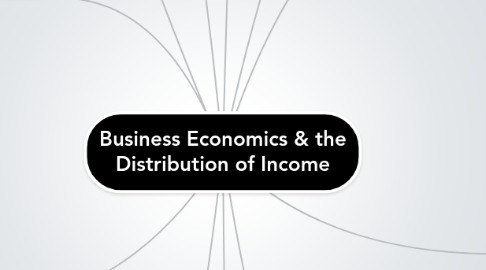
1. Perfect Competition
1.1. Many buyers and sellers
1.2. No barriers to entry or exit
1.3. Identical products
1.4. Perfect information
1.5. No externalities
1.6. No economies of scale
1.7. Perfectly elastic demand curve
1.8. Shut down condition
1.8.1. Short-run : P < AVC
1.8.2. Long-run: P < AC
1.9. Long-run
1.9.1. Firms only make normal profits
2. Efficiency
2.1. Surplus
2.1.1. Consumer surplus
2.1.2. Producer surplus
2.2. Static efficiency
2.2.1. Productive
2.2.2. Allocative
2.2.3. X
2.3. Dynamic efficiency
2.3.1. Product
2.3.2. Process
2.4. Perfect competition
2.4.1. Allocative efficiency as P=MC
2.4.2. Productive efficiency as equilibrium output is supplied at minimum average cost
2.4.3. Dynamic inefficiency due to homogeneous products
2.5. Imperfect competition
2.5.1. Deadweight loss
3. Concentrated Markets
3.1. Concentration ratio
3.2. Growth
3.2.1. Internal / Organic
3.2.2. External
3.2.2.1. Horizontal intergration
3.2.2.2. Vertical intergration
3.2.2.2.1. Forward
3.2.2.2.2. Backward
3.2.2.3. Lateral merger
3.2.2.4. Conglomerate merger
3.3. Outsourcing
4. Monopoly
4.1. Barriers to entry
4.1.1. High fixed costs
4.1.2. Economies of scale
4.1.3. Brand loyalty
4.1.4. Legal barriers
4.1.5. Control over the factors of production
4.1.6. Control over retail outlets
4.1.7. Predatory pricing
4.2. Strategic entry deterrence
4.2.1. Hostile takeovers
4.2.2. Product differentiation
4.2.3. Capacity expansion
4.2.4. Predatory pricing
4.3. Costs
4.3.1. Higher prices and lower output
4.3.2. Allocative inefficiency as P > MC and underconsumption
4.3.3. Reduced consumer surplus
4.3.4. Productive inefficiency
4.3.5. X inefficiency due to protection by barriers to entry
4.4. Benefits
4.4.1. Economies of scale leading to lower prices
4.4.2. Potential to reach M.E.S. with natural monopoly
4.4.3. Dynamic efficiency from supernormal profits
4.4.4. Scope to be internationally competitive
5. New node
6. Profit Maximisation
6.1. Normal profit
6.2. Supernormal profit
6.2.1. AR>AC
6.3. Alternative goals
6.3.1. Traditional
6.3.1.1. Assume
6.3.1.2. Owners are managers
6.3.2. Managerial theories
6.3.2.1. Assume sales,revenue or market share maximisation
6.3.2.2. Divorce between ownership and control
6.3.2.3. Principal-agent problem
6.3.3. Behavioural theories
6.3.3.1. Coalition of goals and satisficing
7. Cost and Revenues
7.1. Cost
7.1.1. Total cost
7.1.1.1. Total average cost
7.1.1.2. Total fixed cost
7.1.2. Marginal cost
7.2. Short run
7.2.1. The law of diminishing returns
7.2.2. Average cost
7.2.2.1. Average fixed cost
7.2.2.2. Average variable cost
7.3. Long run
7.3.1. LRAC
7.3.1.1. Minimum Efficient Scale
7.4. Total product
7.4.1. Marginal product
7.5. Economies of scale
7.5.1. Falling SRAC
7.5.2. Falling LRAC
7.5.3. External Economies of scale
7.6. Diseconomies of scale
7.6.1. External Diseconomies of scale
7.6.1.1. Rising LRAC
7.7. Revenue
7.7.1. Total revenue
7.7.2. Average revenue
7.7.2.1. = Price
7.7.3. Marginal revenue
8. Price Discrimination
8.1. IDENTICAL PRODUCT to DIFFERENT BUYERS at DIFFERENT PRICES for reasons unrelated to costs
8.2. Conditions
8.2.1. Differences in price elasticity of demand
8.2.2. Barriers to prevent ''market seepage''
8.3. First degree (perfect price discrimination)
8.3.1. Unique price
8.4. Second degree
8.4.1. Batches of a product at lower prices than previous batches
8.5. Third degree
8.5.1. By time
8.5.2. By geography
8.5.3. By status
9. Oligopoly
9.1. Market dominated by a FEW PRODUCERS
9.2. Interdependence and uncertainly
9.3. Entry barriers
9.4. Product branding
9.5. Non-price competition
9.6. Competitive
9.6.1. Based on strategic interdependence
9.7. Collusive
9.7.1. Tacit
9.7.2. Explicit
9.8. Kinked demand curve
9.9. Game theory
10. Contestable Markets
10.1. Theory of contestable markets: not the number of firms than influences conduct and performance, but the level of barriers to entry into an industry
10.2. Perfectly contestable: when the costs of entry and exit by potential rivals are 0
10.3. Evaluation
10.3.1. no market is perfectly contestable, i.e. has 0 sunk costs
10.3.2. Threat of hit-and-run competition is insufficient to make incumbent firms change their behaviour
10.3.3. Existing forms protect themselves through patents or strategic entry barriers
10.3.4. Barriers formed by the level of knowledge needed to entry
10.4. Increasing contestability of the markets
10.4.1. Entrepreneurial zeal
10.4.2. Deregulation of markets
10.4.3. Competition policy
10.4.4. The European Single Market
10.4.5. Technological change e.g. e-commerce
11. Market Structure & Technology
11.1. Technology
11.1.1. Lowers AC
11.1.2. Lowers price
11.1.3. Raises quality of products
11.1.4. Gains in dynamic efficiency
11.1.5. Promote competition
11.1.5.1. Reducing entry barriers
11.1.5.2. Reducing concentration
11.1.5.3. Increasing the degree of market contestability
11.1.6. However, reinforce monopoly power if firms patent their innovations, have greater global reach
